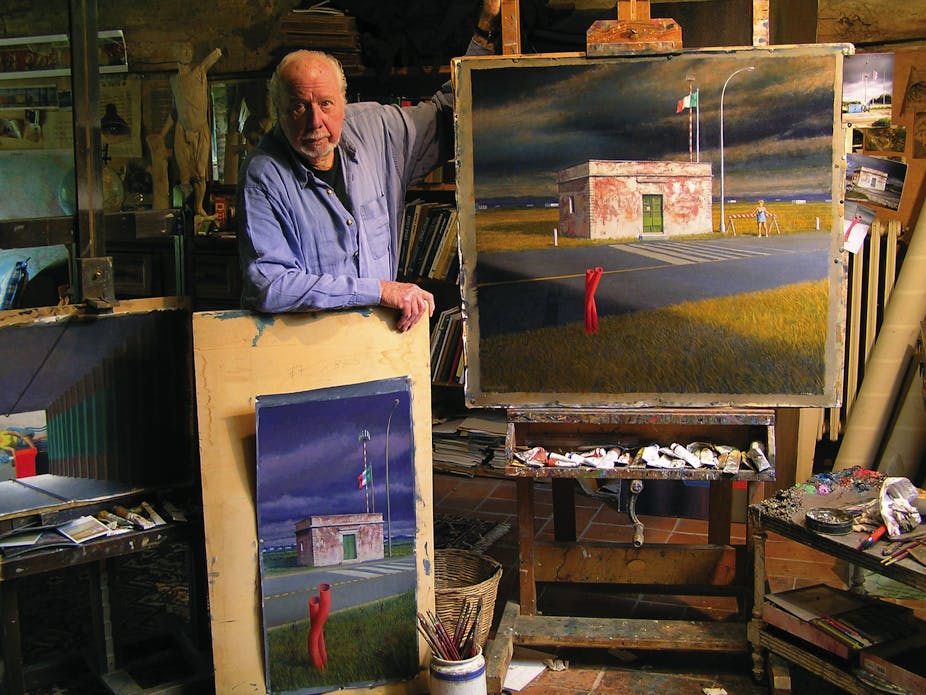Death has a special significance in the history of art. Whenever artists die, a kind of art dies with them. Painting will survive Jeffrey Smart (1921–2013) but the kind of picture that he produced is impossible to paint.
The unique position that Smart occupied in the history of Australian art was to represent urban and roadside environments in all their automotive sterility. If there was a beautiful vista to be beheld, Smart would turn his back on it and find an overpass from which to observe the entrance to a tunnel.
It wasn’t perversity that drew Smart to this contrary aesthetic but more a love of paradox, which happily married many irreconcilable qualities. The focus on industrial motifs allowed Smart to paint repetitious forms, with some of the seriality that he would have witnessed in the more radical genres of minimalism, pop art and op art.
Smart could also eliminate much of the pictorial challenge of painting organic forms with complicated volumetric changes and the chaotic behaviour of shadows, which is an eternal challenge for painters. It then let him formulate scenes that often required simple horizons, sometimes avoiding the middle distance which is also a perpetual problem.
The results were somehow spooky, odd, disconnected. If a person doesn’t match the fence that his or her body rises above, it turns out to be all the more entertaining. Smart not only spared himself a certain amount of difficulty but profited from the air of dislocation: it nicely expressed aspects of the anomalous locations, charged with anti-character and alienation.
For his personal life, Smart chose to live in Italy, a country of exquisite separations: on the one hand, ceremonial urban space of endearing compactness and, on the other hand, a countryside with scenic agriculture interspersed by dense little towns. Painters for hundreds of years have flocked to Italy, not just because of the content of its museums and the classical ruins but because of its multi-storey urban intimacy offset by expansive and gorgeous horticulture.
For his pictorial life, however, Smart chose the autostrada, the places frequented by lorries, the industrial backblocks painted out with crisp primary and secondary colours and hazard-stripes, where a view had no necessary sense of progression from foreground to middleground to background. These places are uninhabitable docks, airports, places of transition and logistical systems in operation.
It’s not that Smart hated what he painted. Rather, he was conscious that the modern world has another visuality from that of the old world, with not only a different set of colours, a different mood, OHS regimes and different space but a bizarre absence of human relationships.

Smart’s contribution was not just to paint curiosities but consistently to analyse the depredations of space wrought by the internal combustion engine. Wherever space is conditioned by contemporary modes of transport, it negates all the preconditions of liveable streets. There are no streets in Smart, only roads. In a land of legendary streetscapes, Smart would concentrate on the places where no one would ever want to be.
Perhaps because of his unerring instinct for finding the crossover between industrial pride and spatial bathos, Smart’s world appeals to us as ironic, humorous, cleverly unsettled. Even a portrait commission would present as an opportunity for Smart to rehearse his penchant for non-space.
For various reasons, representational painting is little practiced today. With Smart’s passing away, it seems even more remote than it did when he recently declared that it was time to let his brushes rest. Realism was considered radical around 1850, and still slightly contemporary in the 1930s. It came to be regarded as conservative in the postwar period and seemed like a regional curiosity throughout Smart’s career.
In the face of so much potential scorn, Australia has been kind to Smart. Collectors and galleries recognised in his work something that is hard to achieve by other means: it’s a meditation on dislocated space, a condition of urban emptiness which has constantly expanded throughout Smart’s long life.
Jeffrey Smart captured it as no one else could. In a century’s time, when so much art will have been forgotten, I can imagine people looking at his work and reflecting: that’s what the age of petrol looked like.

